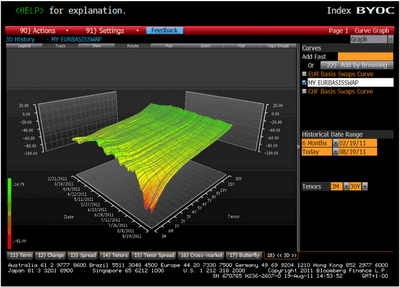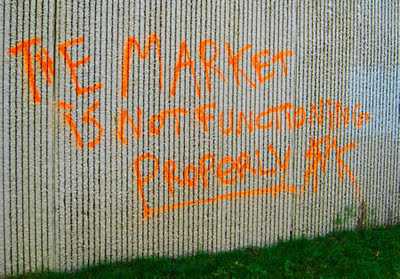I look at the financial statements of the big banks. 10-Qs and the like. I’ve concluded that, for the most part, it’s a waste of time. There are usually 70 or so pages of numbers and discussion. Tons of data. But what is missing is a realistic appraisal of what the assets are actually worth.
Rather than go blind looking at small print I just look at market capitalization and assets. The balance sheet assets are a good proxy for what has to be funded. The market cap (shares outstanding X current market price) is the only number one can look at that is “real”. It is real because the “tape” and the market say so. It is a much more reliable number than what the accountants, auditors and management tell you.
Market cap is critical because there is a presumption that a big bank can go to the equity market and issue preferred and common stock equal to about 10% of the existing market valuation. A big equity valuation is a cushion in troubled times.
Societe Generale, Paris is a big bank that has been much in the news this week. SoGen is a top tier global bank. They have a very large deposit base and consumer business. They are also a big global trading bank. SG is well managed. I would call it one of the Crown Jewels of the financial picture in France. It is a classic Too Big to Fail.
Having said all those nice things about SoGen I also have to point out that it has a very thin margin of market valuation to support its huge balance sheet. The market cap/asset ratios for SoGen, Wells Fargo and JPM:

Looking at this one sees the problem. SoGen is levered 4-6 X’s the US banks.
Under normal circumstances my way of looking at things is irrelevant. It only becomes significant when there are problems. Today we have problems.
There are monstrous gobs of liquidity in the world. But every day that goes by that liquidity is getting more and more risk adverse. Globally there is about $60 Trillion of funded debt of one form or another. That huge amount has to be rolled over constantly. A very substantial portion of this has maturities of less than six months. It is a “faith based” system. The assumption is that there will always be ample liquidity from the holders of cash to roll over everything without a hiccup. At the moment there is not much faith in that system.
The nice folks at FTAlphaville put up this interesting chart Friday afternoon. It tells the story perfectly. Everything is green except the month of August and the very short end of the funding spectrum. The red area is a Short Squeeze. This is also a big Red Alert!

The lower the equity cap of any financial, the greater the risk that there are funding problems. This is what did in Lehman. Almost overnight they lost their funding sources. (Note: This is what happened to Drexel in 1989. I was there. It took ten days to go from soup to nuts.)
SoGen, being what they are, will not be the first bank to suffer liquidity problems. I used their equity numbers to make a point. It is the second tier Euro banks that are going to get squeezed. I have no doubt but they are already feeling the pinch.
I can’t see this going on much longer. We may have already passed the point where the downward spiral on funding availability is irreversible without global central banks stepping in.
.
That brings us to Jackson Hole. Damn near everyone I read is thinking that Bernanke is going to pull a rabbit out of his hat next weekend. Some new form of monetary stimulus will be announced and all will be well for the markets once again. I don’t agree.
While the US has some major league problems, those issues can’t be addressed by the Fed. There is nothing more that the Fed can do. With short-term rates at zero (and planted there for years to come) and the ten-year at 2% there is nothing left to be done. Or is there?
I maintain the next move by the Fed is to massively open up the dollar swap lines with European central banks. I don’t think Bernanke wants to announce this significant step at Jackson Hole. It is an EU issue and the Fed can’t take the lead on this. Opening the swap lines will prove to be very unpopular in the US. Politicians will jump on it as a bailout of Europe while America is struggling.
Bernanke is going to take some heat, when this happens (I think this is now a certainty, just not sure of the timing). But I also think that Bernanke is pushing (as I write) for this to happen. The only option left for Bernanke is to put another half trillion or so into the global system. He can’t do that in the US, but he has a great excuse today to do it in Europe.
I maintain the forum for this is not Jackson Hole. There is too much theater in all of this already. The Europeans don’t want this to be a circus (more than it already is). They want to be seen as responding to an EU problem, they don’t want to be seen as a slave to Bernanke and the Jackson Hole confab.
The announcement of the swap lines will not come from Wyoming. It will happen on a Sunday night. It either happens before next weekend, or the weekend after. Given that things are rapidly unwinding in the EU funding markets I don’t think they want to wait another two full weeks to put a band aid on the problem. They have to do something sooner than that. If they don’t, they risk a full scale liquidity blowout before September. If the blowout were to happen it would be very difficult to reverse. They have to (attempt) to get ahead of the problem before it is a crisis.
I think there is a decent chance this important next step takes place outside of Jackson Hole. It could happen this Sunday night. If I’m wrong, and we get nothing, the European funding markets are going to collapse next week. It will be very difficult to reverse the damage that this will cause. All the central bankers know this. They know that there is not much time left to act. They can’t wait another two weeks.

The Zero Hedge


Leave a Reply